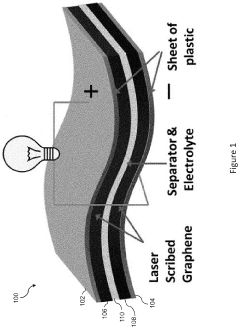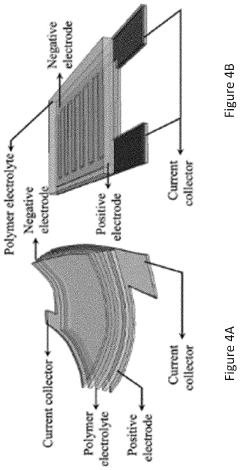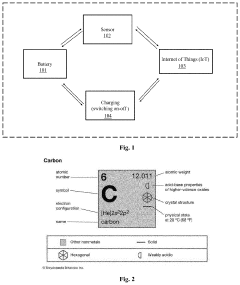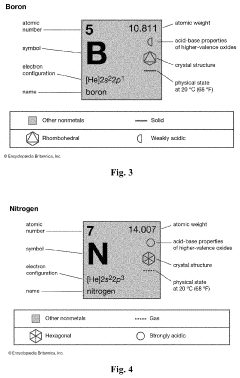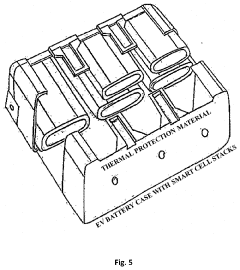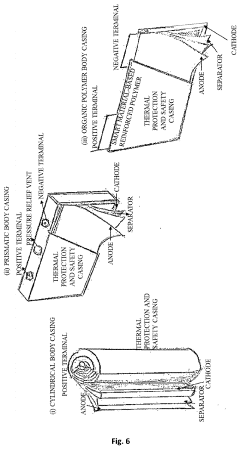Graphene Battery's Role in Renewable Energy Integration
AUG 6, 20259 MIN READ
Generate Your Research Report Instantly with AI Agent
Patsnap Eureka helps you evaluate technical feasibility & market potential.
Graphene Battery Evolution
Graphene batteries have undergone a remarkable evolution since their inception, marking significant milestones in the field of energy storage. The journey began with the discovery of graphene in 2004, which opened up new possibilities for battery technology. Initially, researchers focused on understanding the unique properties of graphene, such as its high electrical conductivity, mechanical strength, and large surface area.
The first major breakthrough came in the early 2010s when scientists successfully incorporated graphene into lithium-ion battery electrodes. This innovation led to improved energy density and faster charging capabilities compared to traditional lithium-ion batteries. As research progressed, the focus shifted towards developing full graphene-based batteries, aiming to harness the material's full potential.
By the mid-2010s, several prototypes of graphene-enhanced batteries emerged, demonstrating superior performance in laboratory settings. These early models showed promising results in terms of energy density, charging speed, and cycle life. However, challenges in scalability and manufacturing processes hindered widespread commercial adoption.
The late 2010s saw a surge in research efforts to overcome these challenges. Scientists explored various graphene forms, including graphene oxide and reduced graphene oxide, to optimize battery performance. Concurrently, advancements in production techniques, such as chemical vapor deposition and liquid-phase exfoliation, improved the quality and quantity of graphene available for battery manufacturing.
A significant milestone was reached in 2019 when researchers developed a graphene-based battery that could charge electric vehicles in just 15 minutes. This breakthrough highlighted the potential of graphene batteries in revolutionizing the electric vehicle industry and, by extension, renewable energy integration.
Recent years have witnessed a shift towards hybrid systems, combining graphene with other advanced materials to create synergistic effects. For instance, graphene-silicon composite anodes have shown exceptional capacity and stability, addressing some of the limitations of pure graphene electrodes.
The evolution of graphene batteries has also been marked by increasing focus on sustainability and environmental impact. Researchers are exploring eco-friendly production methods and investigating the potential of graphene in improving the recyclability of batteries, aligning with the broader goals of renewable energy integration.
As we move into the 2020s, the graphene battery landscape continues to evolve rapidly. Current research is exploring novel architectures, such as 3D graphene structures and graphene aerogels, to further enhance battery performance. Additionally, there is growing interest in applying graphene batteries to grid-scale energy storage, which could play a crucial role in stabilizing renewable energy sources and improving overall grid reliability.
The first major breakthrough came in the early 2010s when scientists successfully incorporated graphene into lithium-ion battery electrodes. This innovation led to improved energy density and faster charging capabilities compared to traditional lithium-ion batteries. As research progressed, the focus shifted towards developing full graphene-based batteries, aiming to harness the material's full potential.
By the mid-2010s, several prototypes of graphene-enhanced batteries emerged, demonstrating superior performance in laboratory settings. These early models showed promising results in terms of energy density, charging speed, and cycle life. However, challenges in scalability and manufacturing processes hindered widespread commercial adoption.
The late 2010s saw a surge in research efforts to overcome these challenges. Scientists explored various graphene forms, including graphene oxide and reduced graphene oxide, to optimize battery performance. Concurrently, advancements in production techniques, such as chemical vapor deposition and liquid-phase exfoliation, improved the quality and quantity of graphene available for battery manufacturing.
A significant milestone was reached in 2019 when researchers developed a graphene-based battery that could charge electric vehicles in just 15 minutes. This breakthrough highlighted the potential of graphene batteries in revolutionizing the electric vehicle industry and, by extension, renewable energy integration.
Recent years have witnessed a shift towards hybrid systems, combining graphene with other advanced materials to create synergistic effects. For instance, graphene-silicon composite anodes have shown exceptional capacity and stability, addressing some of the limitations of pure graphene electrodes.
The evolution of graphene batteries has also been marked by increasing focus on sustainability and environmental impact. Researchers are exploring eco-friendly production methods and investigating the potential of graphene in improving the recyclability of batteries, aligning with the broader goals of renewable energy integration.
As we move into the 2020s, the graphene battery landscape continues to evolve rapidly. Current research is exploring novel architectures, such as 3D graphene structures and graphene aerogels, to further enhance battery performance. Additionally, there is growing interest in applying graphene batteries to grid-scale energy storage, which could play a crucial role in stabilizing renewable energy sources and improving overall grid reliability.
Renewable Energy Market Needs
The renewable energy market is experiencing unprecedented growth, driven by global efforts to combat climate change and reduce dependence on fossil fuels. This surge in demand for clean energy solutions has created a pressing need for advanced energy storage technologies, particularly in the realm of battery systems. Graphene batteries have emerged as a promising candidate to address the unique challenges posed by renewable energy integration.
One of the primary market needs in the renewable energy sector is the ability to effectively store and distribute intermittent energy sources such as solar and wind power. Traditional lithium-ion batteries, while widely used, face limitations in terms of energy density, charging speed, and cycle life. Graphene batteries offer potential solutions to these challenges, with their superior conductivity and structural properties enabling faster charging times and higher energy densities.
The renewable energy market also demands scalable and cost-effective storage solutions to support grid-level integration. Graphene batteries show promise in this area, as their potential for increased energy density could lead to more compact and efficient storage systems. This scalability is crucial for utilities and grid operators looking to implement large-scale energy storage projects to balance supply and demand fluctuations inherent in renewable energy generation.
Another significant market need is the development of environmentally friendly and sustainable energy storage technologies. Graphene batteries align well with this requirement, as they have the potential to be more recyclable and use fewer toxic materials compared to conventional battery technologies. This aspect is particularly important as the renewable energy sector seeks to minimize its environmental footprint across the entire value chain.
The electric vehicle (EV) market, a key driver of renewable energy adoption, presents additional demands for advanced battery technologies. Graphene batteries could potentially address range anxiety concerns by offering higher energy densities and faster charging capabilities. This would not only benefit individual EV owners but also support the broader integration of renewable energy into transportation systems.
In the context of off-grid and microgrid applications, particularly in remote or developing regions, there is a growing need for robust and long-lasting energy storage solutions. Graphene batteries' potential for extended cycle life and improved performance in extreme conditions could make them ideal for these challenging environments, further expanding the reach of renewable energy technologies.
As the renewable energy market continues to evolve, there is an increasing emphasis on smart grid technologies and demand response systems. Graphene batteries, with their potential for rapid charge and discharge capabilities, could play a crucial role in enabling more responsive and flexible energy management systems, enhancing grid stability and efficiency.
One of the primary market needs in the renewable energy sector is the ability to effectively store and distribute intermittent energy sources such as solar and wind power. Traditional lithium-ion batteries, while widely used, face limitations in terms of energy density, charging speed, and cycle life. Graphene batteries offer potential solutions to these challenges, with their superior conductivity and structural properties enabling faster charging times and higher energy densities.
The renewable energy market also demands scalable and cost-effective storage solutions to support grid-level integration. Graphene batteries show promise in this area, as their potential for increased energy density could lead to more compact and efficient storage systems. This scalability is crucial for utilities and grid operators looking to implement large-scale energy storage projects to balance supply and demand fluctuations inherent in renewable energy generation.
Another significant market need is the development of environmentally friendly and sustainable energy storage technologies. Graphene batteries align well with this requirement, as they have the potential to be more recyclable and use fewer toxic materials compared to conventional battery technologies. This aspect is particularly important as the renewable energy sector seeks to minimize its environmental footprint across the entire value chain.
The electric vehicle (EV) market, a key driver of renewable energy adoption, presents additional demands for advanced battery technologies. Graphene batteries could potentially address range anxiety concerns by offering higher energy densities and faster charging capabilities. This would not only benefit individual EV owners but also support the broader integration of renewable energy into transportation systems.
In the context of off-grid and microgrid applications, particularly in remote or developing regions, there is a growing need for robust and long-lasting energy storage solutions. Graphene batteries' potential for extended cycle life and improved performance in extreme conditions could make them ideal for these challenging environments, further expanding the reach of renewable energy technologies.
As the renewable energy market continues to evolve, there is an increasing emphasis on smart grid technologies and demand response systems. Graphene batteries, with their potential for rapid charge and discharge capabilities, could play a crucial role in enabling more responsive and flexible energy management systems, enhancing grid stability and efficiency.
Graphene Battery Challenges
Despite the promising potential of graphene batteries in renewable energy integration, several significant challenges hinder their widespread adoption and commercialization. These obstacles span technical, economic, and practical domains, requiring concerted efforts from researchers, manufacturers, and policymakers to overcome.
One of the primary technical challenges is achieving consistent and scalable production of high-quality graphene. The exceptional properties of graphene are highly dependent on its structural integrity, and current manufacturing processes often result in defects or impurities that compromise performance. Developing reliable, cost-effective methods for large-scale graphene production remains a critical hurdle.
Another technical obstacle is the optimization of graphene's integration with other battery components. While graphene exhibits excellent conductivity and surface area, effectively incorporating it into electrodes, electrolytes, or other battery structures without compromising its unique properties is complex. Researchers must fine-tune the interface between graphene and other materials to maximize energy density, charge/discharge rates, and overall battery efficiency.
Stability and longevity pose additional challenges for graphene batteries. Although graphene can potentially enhance battery life, long-term cycling stability under various environmental conditions and usage patterns needs further investigation. Addressing issues such as capacity fade, thermal management, and resistance to degradation is crucial for ensuring the reliability of graphene batteries in renewable energy applications.
From an economic perspective, the cost of graphene production and battery manufacturing remains a significant barrier. While graphene prices have decreased over time, they are still considerably higher than traditional battery materials. Achieving cost parity or demonstrating a compelling cost-benefit ratio is essential for widespread adoption in the price-sensitive energy storage market.
Practical challenges also exist in scaling up graphene battery production from laboratory prototypes to commercial-scale manufacturing. This transition requires substantial investment in production facilities, quality control processes, and supply chain management. Additionally, integrating graphene batteries into existing renewable energy systems and grid infrastructure may necessitate modifications to current designs and operational practices.
Regulatory and safety considerations present another set of challenges. As a relatively new technology, graphene batteries must undergo rigorous testing and certification to meet industry standards and safety regulations. Addressing concerns related to environmental impact, recyclability, and potential health effects of graphene materials is crucial for gaining public acceptance and regulatory approval.
Overcoming these multifaceted challenges requires a collaborative approach involving interdisciplinary research, industry partnerships, and supportive policy frameworks. As progress continues in addressing these obstacles, graphene batteries hold the potential to play a transformative role in enhancing the efficiency and reliability of renewable energy integration.
One of the primary technical challenges is achieving consistent and scalable production of high-quality graphene. The exceptional properties of graphene are highly dependent on its structural integrity, and current manufacturing processes often result in defects or impurities that compromise performance. Developing reliable, cost-effective methods for large-scale graphene production remains a critical hurdle.
Another technical obstacle is the optimization of graphene's integration with other battery components. While graphene exhibits excellent conductivity and surface area, effectively incorporating it into electrodes, electrolytes, or other battery structures without compromising its unique properties is complex. Researchers must fine-tune the interface between graphene and other materials to maximize energy density, charge/discharge rates, and overall battery efficiency.
Stability and longevity pose additional challenges for graphene batteries. Although graphene can potentially enhance battery life, long-term cycling stability under various environmental conditions and usage patterns needs further investigation. Addressing issues such as capacity fade, thermal management, and resistance to degradation is crucial for ensuring the reliability of graphene batteries in renewable energy applications.
From an economic perspective, the cost of graphene production and battery manufacturing remains a significant barrier. While graphene prices have decreased over time, they are still considerably higher than traditional battery materials. Achieving cost parity or demonstrating a compelling cost-benefit ratio is essential for widespread adoption in the price-sensitive energy storage market.
Practical challenges also exist in scaling up graphene battery production from laboratory prototypes to commercial-scale manufacturing. This transition requires substantial investment in production facilities, quality control processes, and supply chain management. Additionally, integrating graphene batteries into existing renewable energy systems and grid infrastructure may necessitate modifications to current designs and operational practices.
Regulatory and safety considerations present another set of challenges. As a relatively new technology, graphene batteries must undergo rigorous testing and certification to meet industry standards and safety regulations. Addressing concerns related to environmental impact, recyclability, and potential health effects of graphene materials is crucial for gaining public acceptance and regulatory approval.
Overcoming these multifaceted challenges requires a collaborative approach involving interdisciplinary research, industry partnerships, and supportive policy frameworks. As progress continues in addressing these obstacles, graphene batteries hold the potential to play a transformative role in enhancing the efficiency and reliability of renewable energy integration.
Current Graphene Solutions
01 Graphene-based electrode materials
Graphene is used as an electrode material in batteries due to its high conductivity and large surface area. It can be incorporated into both anodes and cathodes to improve battery performance, including increased capacity and faster charging rates.- Graphene-based electrode materials: Graphene is used as an electrode material in batteries due to its high conductivity and large surface area. This can enhance the battery's performance, including improved energy density and faster charging rates. Various forms of graphene, such as graphene oxide or reduced graphene oxide, can be incorporated into electrode structures to optimize battery performance.
- Graphene-enhanced electrolytes: Graphene can be incorporated into battery electrolytes to improve their conductivity and stability. This can lead to better ion transport within the battery, potentially increasing its overall efficiency and lifespan. Graphene-based additives in electrolytes may also help to prevent dendrite formation in lithium-ion batteries.
- Graphene composite materials for battery components: Composite materials combining graphene with other substances, such as metal oxides or polymers, are developed for use in various battery components. These composites can enhance the mechanical and electrochemical properties of battery electrodes, separators, or current collectors, leading to improved battery performance and durability.
- Graphene-based flexible and wearable batteries: Graphene's flexibility and strength make it suitable for developing flexible and wearable battery technologies. These batteries can be integrated into clothing, accessories, or other flexible devices, opening up new possibilities for portable energy storage in various applications.
- Manufacturing processes for graphene-based battery components: Various manufacturing techniques are developed to produce graphene-based battery components efficiently and at scale. These may include methods for synthesizing graphene materials, coating electrodes with graphene, or integrating graphene into existing battery production processes. The focus is on developing cost-effective and scalable manufacturing methods to enable widespread adoption of graphene-enhanced batteries.
02 Graphene-enhanced electrolytes
Graphene can be used to enhance battery electrolytes, improving ionic conductivity and stability. This can lead to better overall battery performance, including increased energy density and longer cycle life.Expand Specific Solutions03 Graphene-based composite materials
Composite materials incorporating graphene are developed for use in battery components. These composites can combine the beneficial properties of graphene with other materials to create high-performance electrodes or other battery parts.Expand Specific Solutions04 Graphene production methods for battery applications
Specialized methods for producing graphene tailored for battery applications are developed. These methods focus on creating graphene with specific properties that are beneficial for battery performance, such as controlled porosity or functionalization.Expand Specific Solutions05 Graphene-based flexible and wearable batteries
Graphene's flexibility and strength make it suitable for developing flexible and wearable battery technologies. These batteries can be integrated into clothing or other wearable devices, offering new possibilities for portable power sources.Expand Specific Solutions
Key Graphene Battery Players
The graphene battery market for renewable energy integration is in its early growth stage, characterized by rapid technological advancements and increasing market potential. The global market size is expanding, driven by the growing demand for efficient energy storage solutions in renewable energy systems. While the technology is promising, it is still evolving towards full commercial maturity. Key players like Northwestern University, Lawrence Livermore National Security LLC, and Honeycomb Battery Co. are at the forefront of research and development, focusing on improving battery performance, scalability, and cost-effectiveness. Companies such as NEC Corp. and Martinrea International, Inc. are exploring industrial applications, indicating a gradual shift towards commercialization. The competitive landscape is diverse, with academic institutions, national laboratories, and private companies all contributing to technological progress.
NEC Corp.
Technical Solution: NEC Corporation has been actively developing graphene-based technologies for energy storage applications, with a focus on integrating these solutions into renewable energy systems. Their approach involves using graphene as an additive in lithium-ion battery electrodes to enhance conductivity and structural stability. NEC has reported significant improvements in battery capacity and charging speeds, with their graphene-enhanced batteries showing up to 30% increase in energy density compared to conventional lithium-ion batteries[5]. The company is also exploring the use of graphene in solid-state batteries, which could potentially offer even greater energy density and safety benefits for renewable energy storage. NEC's research indicates that their graphene-based batteries could maintain over 80% of their initial capacity after 3000 charge cycles, making them highly suitable for long-term renewable energy storage applications[6].
Strengths: Strong R&D capabilities, existing manufacturing infrastructure, and potential for rapid commercialization. Weaknesses: Competition from other established battery manufacturers and potential patent conflicts in graphene technology.
Beijing Asahi Carbon New Material Technology Co., Ltd.
Technical Solution: Beijing Asahi Carbon New Material Technology Co., Ltd. has been developing advanced graphene materials specifically tailored for energy storage applications in renewable energy systems. Their proprietary graphene production process allows for the creation of high-quality, large-area graphene sheets with controlled thickness and porosity. These graphene materials are being integrated into lithium-sulfur batteries, which offer theoretical energy densities up to five times higher than traditional lithium-ion batteries[7]. The company's graphene-enhanced lithium-sulfur batteries have demonstrated improved cycle life and reduced capacity fading, addressing key challenges in sulfur cathode stability. Initial tests have shown that their batteries can maintain over 70% capacity after 500 cycles, a significant improvement over conventional lithium-sulfur batteries[8]. Beijing Asahi is also exploring the use of their graphene materials in flow batteries for grid-scale energy storage, potentially offering a more cost-effective solution for large-scale renewable energy integration.
Strengths: Specialized graphene production capabilities, focus on high-energy-density battery chemistries, and potential for cost-effective large-scale energy storage. Weaknesses: Limited track record in battery production and potential challenges in scaling up new battery technologies.
Graphene Battery Innovations
Graphene battery as energy storage for appliances
PatentInactiveUS20220416568A1
Innovation
- The implementation of graphene batteries as a powerwall solution for homes and businesses, which can store energy from solar or other sources, providing backup power during outages and reducing energy costs by charging at night or through solar power, and utilizing energy storage to smooth out variable energy resources.
Systems, methods and apparatus for improving rechargeable energy storage devices and integrated circuits
PatentActiveUS20230092765A1
Innovation
- The development of a smart rechargeable energy storage device using pure organic carbon-based graphene in a solid-state configuration, with graphene sheets forming the anode and cathode electrodes and serving as a separator, enabling faster charging, longer cycle life, and enhanced energy density, while eliminating safety hazards through self-healing and safer materials.
Environmental Impact Analysis
The integration of graphene batteries in renewable energy systems presents both opportunities and challenges from an environmental perspective. These advanced energy storage solutions offer significant potential to enhance the efficiency and reliability of renewable energy sources, particularly in addressing intermittency issues associated with solar and wind power.
Graphene batteries demonstrate superior energy density and faster charging capabilities compared to traditional lithium-ion batteries. This increased efficiency translates to reduced energy losses during storage and distribution, potentially lowering the overall carbon footprint of renewable energy systems. Furthermore, the extended lifespan of graphene batteries may lead to a decrease in electronic waste, as fewer replacements would be required over time.
However, the environmental impact of graphene production must be carefully considered. The manufacturing process of graphene can be energy-intensive and may involve the use of hazardous chemicals. As the demand for graphene batteries increases, it is crucial to develop and implement sustainable production methods to mitigate potential negative environmental effects.
The recyclability of graphene batteries is another critical factor in assessing their environmental impact. While research is ongoing, initial studies suggest that graphene-based materials may be more easily recyclable than traditional battery components. This could lead to a more circular economy in the energy storage sector, reducing the need for raw material extraction and minimizing waste.
In terms of land use, graphene batteries could potentially reduce the physical footprint of energy storage facilities due to their higher energy density. This could be particularly beneficial in urban areas or regions with limited available space for renewable energy infrastructure.
The integration of graphene batteries with renewable energy sources may also contribute to grid stability and resilience. By providing more efficient and responsive energy storage, these batteries could help balance supply and demand, reducing the need for fossil fuel-based peaker plants and their associated emissions.
As with any emerging technology, long-term environmental monitoring will be essential to fully understand the ecological implications of widespread graphene battery adoption. This includes assessing potential impacts on air and water quality, as well as any unforeseen effects on ecosystems.
Graphene batteries demonstrate superior energy density and faster charging capabilities compared to traditional lithium-ion batteries. This increased efficiency translates to reduced energy losses during storage and distribution, potentially lowering the overall carbon footprint of renewable energy systems. Furthermore, the extended lifespan of graphene batteries may lead to a decrease in electronic waste, as fewer replacements would be required over time.
However, the environmental impact of graphene production must be carefully considered. The manufacturing process of graphene can be energy-intensive and may involve the use of hazardous chemicals. As the demand for graphene batteries increases, it is crucial to develop and implement sustainable production methods to mitigate potential negative environmental effects.
The recyclability of graphene batteries is another critical factor in assessing their environmental impact. While research is ongoing, initial studies suggest that graphene-based materials may be more easily recyclable than traditional battery components. This could lead to a more circular economy in the energy storage sector, reducing the need for raw material extraction and minimizing waste.
In terms of land use, graphene batteries could potentially reduce the physical footprint of energy storage facilities due to their higher energy density. This could be particularly beneficial in urban areas or regions with limited available space for renewable energy infrastructure.
The integration of graphene batteries with renewable energy sources may also contribute to grid stability and resilience. By providing more efficient and responsive energy storage, these batteries could help balance supply and demand, reducing the need for fossil fuel-based peaker plants and their associated emissions.
As with any emerging technology, long-term environmental monitoring will be essential to fully understand the ecological implications of widespread graphene battery adoption. This includes assessing potential impacts on air and water quality, as well as any unforeseen effects on ecosystems.
Graphene Battery Economics
The economic implications of graphene batteries in renewable energy integration are multifaceted and potentially transformative. As the renewable energy sector continues to grow, the need for efficient and cost-effective energy storage solutions becomes increasingly critical. Graphene batteries offer several economic advantages that could significantly impact the renewable energy landscape.
Firstly, the high energy density of graphene batteries translates to reduced storage costs per kilowatt-hour. This improved efficiency allows for more compact and lightweight storage systems, potentially decreasing installation and maintenance expenses for renewable energy projects. The reduced footprint of storage facilities could lead to lower land acquisition costs and more flexible deployment options, particularly in urban or space-constrained environments.
Moreover, the extended lifespan of graphene batteries compared to traditional lithium-ion batteries presents a compelling economic case. With the potential for thousands of charge-discharge cycles without significant degradation, graphene batteries could substantially reduce the frequency of battery replacements in renewable energy systems. This longevity not only cuts down on replacement costs but also minimizes system downtime and associated revenue losses.
The rapid charging capabilities of graphene batteries offer another economic advantage. In renewable energy applications, this feature allows for more efficient capture and storage of intermittent energy sources like solar and wind. The ability to quickly store excess energy during peak production periods and rapidly discharge during high demand or low production times enhances grid stability and reduces the need for costly backup power systems.
From a manufacturing perspective, the potential for simplified production processes of graphene batteries could lead to reduced manufacturing costs as the technology matures. While initial production costs may be high due to the novelty of the technology, economies of scale and advancements in graphene synthesis techniques are expected to drive down costs over time.
The integration of graphene batteries in renewable energy systems also has broader economic implications. By enhancing the reliability and efficiency of renewable energy sources, these batteries could accelerate the transition away from fossil fuels, potentially reducing energy costs for consumers and businesses in the long term. This shift could stimulate economic growth in the renewable energy sector, creating new jobs and investment opportunities.
However, it's important to note that the economic viability of graphene batteries in renewable energy integration depends on overcoming current challenges in large-scale production and further reducing costs to compete with established battery technologies. As research and development progress, the economic landscape of graphene batteries in renewable energy is likely to evolve, potentially reshaping the economics of sustainable energy systems.
Firstly, the high energy density of graphene batteries translates to reduced storage costs per kilowatt-hour. This improved efficiency allows for more compact and lightweight storage systems, potentially decreasing installation and maintenance expenses for renewable energy projects. The reduced footprint of storage facilities could lead to lower land acquisition costs and more flexible deployment options, particularly in urban or space-constrained environments.
Moreover, the extended lifespan of graphene batteries compared to traditional lithium-ion batteries presents a compelling economic case. With the potential for thousands of charge-discharge cycles without significant degradation, graphene batteries could substantially reduce the frequency of battery replacements in renewable energy systems. This longevity not only cuts down on replacement costs but also minimizes system downtime and associated revenue losses.
The rapid charging capabilities of graphene batteries offer another economic advantage. In renewable energy applications, this feature allows for more efficient capture and storage of intermittent energy sources like solar and wind. The ability to quickly store excess energy during peak production periods and rapidly discharge during high demand or low production times enhances grid stability and reduces the need for costly backup power systems.
From a manufacturing perspective, the potential for simplified production processes of graphene batteries could lead to reduced manufacturing costs as the technology matures. While initial production costs may be high due to the novelty of the technology, economies of scale and advancements in graphene synthesis techniques are expected to drive down costs over time.
The integration of graphene batteries in renewable energy systems also has broader economic implications. By enhancing the reliability and efficiency of renewable energy sources, these batteries could accelerate the transition away from fossil fuels, potentially reducing energy costs for consumers and businesses in the long term. This shift could stimulate economic growth in the renewable energy sector, creating new jobs and investment opportunities.
However, it's important to note that the economic viability of graphene batteries in renewable energy integration depends on overcoming current challenges in large-scale production and further reducing costs to compete with established battery technologies. As research and development progress, the economic landscape of graphene batteries in renewable energy is likely to evolve, potentially reshaping the economics of sustainable energy systems.
Unlock deeper insights with Patsnap Eureka Quick Research — get a full tech report to explore trends and direct your research. Try now!
Generate Your Research Report Instantly with AI Agent
Supercharge your innovation with Patsnap Eureka AI Agent Platform!
